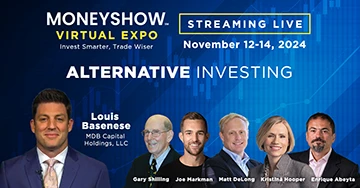For the first time since 2007, investors have multiple ways to succeed this year. Understanding how the lingering effects of deleveraging are colliding with emerging forces of inflation will now define your investing career, writes MoneyShow Chairman and Founder Charles Githler in this exclusive commentary.
The worst is over for investors, and an improving environment awaits us in 2012, according to the MoneyShow experts who proved most accurate last year. Nor will the European sovereign debt crisis whipsaw the markets with last year's ferocity.
The bad news: "our old friend," inflation, is still on its way back.
Its return was our top forecast last year. But the European crisis postponed the comeback, the same way it frustrated predictions for an equities rally, $120 crude, a spike in interest rates, a Chinese boom, and a pickup in mergers.
The euro's weakness helped bear out forecasts for surprising dollar strength and a record gold price, though bullion pulled up well short of the $2,400 per ounce prophesied by our source a year ago.
The call for a rebound in municipal bonds proved spot-on, with the iShares S&P National Municipal ETF (MUB) rallying 18% from its 2011 trough to last week's peak.
When inflation returns, new market manias will emerge and the engorged bond bubble will pop. Monetarists and sage investors warn this is only a matter of time: "Money supply creation is the definition of inflation," said Nobel laureate Milton Friedman, who keynoted several Money Shows during the 1990s.
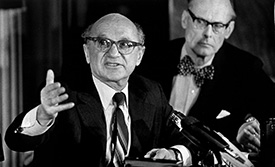 |
| Milton Friedman: "Inflation is coming," Nobel Prize-winning economist told Money Show audiences. Money creation can create growth in the short term, but always creates inflation longer term. |
The global money-printing spree over the last three years has been nothing short of colossal: $500 billion in China, on top of $1.85 trillion in the US-which may not be finished-and $2.6 trillion more is required in Europe, according to economist David Malpass. Malpass still worries about "an implosion" of the European banking system, which is almost four times larger than its US counterpart.
Matthew Lynn of MarketWatch argues that gold can't lose. Either the European Central Bank gets busy printing currency to finance bulk purchases of ailing sovereign bonds (which have admittedly performed much better recently), or else the euro will suffer a chaotic breakup.
The extra currency is likely to seek out stores of value. And, under the worst-case scenario, money hoarders might also seek to convert their paper into bullion.
The good news: markets expect Europe to avoid a complete financial collapse. The bad news: a wave of inflation and new asset price bubbles is on the way. But that's tomorrow's problem (and opportunity). Investors who understand and prepare their portfolios will survive and profit from the coming economic transformation.
The timing of this shift is tricky to predict. Our generational problem-the massive overhang of public and private debt-has produced powerful deflationary forces, as in Japan and here during the Great Depression. The excess debt is a heavier burden than the 1970s inflation, and its effects will be felt for most of this decade.
1. Deflation to Inflation
This is the leading trend to
monitor, because its arrival and extent will surprise most investors, who have,
after a 30-year period of disinflation, come to expect more of the same, as well
as ever-lower interest rates.
Markets react sharpest to surprises-witness last summer and fall, when the Dow would crash, then jump hundreds of points based on news from Europe's debt crisis "front."
This is such an important and under-covered investment topic that we have dedicated a keynote panel to it on February 9 at The World Money Show, titled "Deflation to Inflation and New Market Bubbles: The 2012-2014 Investment Roadmap." You can watch, hear, and meet Senseless Panic author Bill Isaac, Age of Deleveraging author Gary Shilling, top economic forecaster David Wyss, and our favorite political commentator and economic and tax policy expert, Steve Forbes.
The winners coming out of this tricky chapter will be those who can tell the difference between a false start and the "real deal" when inflation finally re-emerges from massive currency debasement. Keep your eyes peeled on three markets, starting with the largest: the US Government bond market.
The 30-year US Treasury bond was still hovering below a 3% yield as we started the year. The transition will start if the long bond's yield successfully breaks above technical resistance at the October 2011 high of 3.45%, according to MoneyShow's "Charts in Play" senior editor Tom Aspray.
"Then, a weekly close above 4.85% would end the long-term secular decline in interest rates," he says.
Copper will be the second harbinger of a global recovery and the return of inflation. Because of its widespread use in cyclical industries such as housing, the red metal is said to "have a Ph.D. in economics."
So far this year, copper has contradicted bonds, breaking to a four-month high in January. If the copper price breaks above its 2011 high of $4.58, we are off to the races.
Gold is a third tool to confirm the turn. As with the oil markets, external factors often move gold's price, since governments hold large reserves.
Ever since I started watching gold in the 1970s, governments have been prone to shock markets by selling enough to depress the metal's price. More recently, central banks in emerging markets have bought gold to diversify their reserves away from the US dollar.
To the surprise of many, gold soared as history-making deflationary forces caused a currency and sovereign-debt market panic. A false alarm as an inflation omen?
Use gold as part of your inflation weathervane-combine gold with oil, copper, and most importantly, those yield "price points" of the 30-year Treasury. Taken together, they will provide empirical "proof" that a break from the long downward slog is finally materializing.
Ironically, this generational turn will almost certainly come amid broad skepticism and with surprisingly little fanfare. The SPDR Gold Trust ETF (GLD) price point to watch is $1 above the 2011 high of $186, which is equivalent to a $1,900 gold bullion price. Calling for a big bull market in gold was part of the characteristically sage forecast last year by newsletter and investment conference pioneer Harry Schultz.
NEXT: 2. Financials Finally Recover.Remember 2009?
|pagebreak|2. Financials Finally Recover.Remember 2009?
That year
featured the stunning outperformance of financial stocks like Bank of
America (BAC), which Bill Isaac recommended on my 2009 keynote panel,
and which ran from a low of $3 to a high of $18.
The Euro crisis has again pushed the world's largest banks and brokers to unusually low valuations. To get paid while you play this recovery, Tom Lydon's ETF Trends noted that the PowerShares Financial Preferred ETF (PGF) still pays a 7% dividend.
3. Stocks Rise.Doing What They Were Expected to Do Last
Year
Although the US economy will not rebound with thunderous
strength, the S&P 500 is forecast to rise from its 2011 round-trip
performance-which left it flat at 1,257 for the year-to as high as 1,426,
according to Standard and Poor's December Quarterly Summary.
The new highs posted in January among important sectors like financials, biotechnology, materials, miners, and industrials support the positive market forecasts. Along with selected retailers, these were my overweight holdings at press time.
Jim Oberweis, editor of The Oberweis Report, tells us that patience will pay. Investors' risk aversion rose markedly in 2011, to levels not seen since late 2008 and early 2009.
"With the P/E multiples for small-cap growth stocks already at the low end of their historical range, we believe an upward bounce is much more likely than a further decline, even if the economy does not show robust growth," he said.
The 36-year-old Oberweis Report recommends and follows 55 mostly small-cap growth stocks that have appreciated at a 19.4% compound annual growth rate over those three and a half decades, according to the publisher. Current picks include: Authen Tec (AUTH), Berkshire Hills Bankcorp (BHLB), and SXC Health Solutions (SXCI).
First Trust's Chief Economist Brian Wesbury cites seven forces that will propel stocks higher this year by 20%:
- Consumer spending is at all-time highs.
- Retail sales continue to be solid.
- The Fed is extremely easy, and will continue to be so for quite some time.
- Government spending has flattened as a percentage of GDP-and is starting to decline. Private payrolls are up for 22 straight months.
- The Institute for Supply Management (ISM) Manufacturing index has been showing growth in the manufacturing sector for 29 consecutive months.
- Corporate cash and profits are at all-time record highs.
4. Bonds Rise, Because the US Economic Recovery Is Its Slowest
Ever
The bond play here is a low-cost ETF that packs in the
high-octane portion of zero-coupon US Treasuries. Its price action is even more
sensitive to inflation and economic expansion expectations than the 30-year
Treasury bond.
The Vanguard Extended Duration Treasury Index ETF (EDV) was up 55.81% through December 2011, according to our friends at Morningstar. That astonishing annual return almost perfectly matches the 56% performance of EDV during the worst period of the US financial crises-the pre-deflation year of 2008.
Behind the headlines and pundits' assurances that a euro collapse won't happen, what did the world's largest investors tell us they were really thinking by driving up prices of US Treasury bonds by as much as 50% again, during the third quarter of last year?
For our January 2011 forecast story, we linked you to Gary Shilling's "Buy Treasuries" article on MoneyShow.com. In January of 2012, I was personally holding as much as 40% in ten- and 30-year US Treasury bonds. It's been a profitable, safe-haven hedge as deflation lingers longer than almost anyone could have predicted. (I plan to periodically reduce that holding throughout the year.)
A warning: Holding such long-dated maturities in such a large proportion of your portfolio evokes reflexive, sometimes emotional criticism from financial advisors and colleagues. Despite their profitable performance and safety (US Treasuries of all maturities are the only asset on which brokers lend 90%) long bonds risk losses from currency depreciation-of which a tidal wave is eventually coming.
But meanwhile (for at least much of 2012), one of our favorite contrarians, Dennis Gartman of The Gartman Letter, warns of too much expectation for declining bond prices: "Everyone is trying to get short the long bond."
Long-term bonds are increasingly vulnerable to brutal corrections as the return of inflation and an economic recovery approaches. For example, from the all-time high in early December 2008 (when the 30-year yield touched 2.52%), EDV then fell sharply (36%) when stocks began a dramatic recovery from their March 2009 low.
Gartman is telling us, remarkably, that bond-market sentiment still has a long way to swing before a market top, when sentiment could turn universally bullish. This is a classic pattern: three and a half decades of bond gains as steady disinflation surprises inflation-weary investors. Then, these past four years of financial crises puts the long bond market in a near vertical ascent.
Retail and institutional investors are notorious for jumping in at or near every important market top. Make a habit of following both the ten-year and the 30-year Treasury bond yields. John Dessauer told us years ago that these are among the most telling economic and inflation barometers.
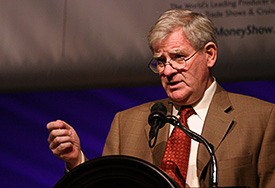 |
| John Dessauer: "The most reliable inflation gauge is the US Treasury Bond" |
Despite encouraging data, S&P economists Beth Ann Bovino and David Wyss suggest that Japanese-style deflation could still unfold in the US. Such a scenario would be worse in Europe.
Fear of inflation from the 1970s is almost dead. Now three decades long, this disinflation trend won't die easily, either. Long Treasuries are increasingly in vogue.
Barron's recently featured Van Hoisington, manager of $5.7 billion in assets, including the Wasatch-Hoisington US Treasury Fund (WHOSX) that was up 41% in 2011. He said: "Bond yields will either continue to go down or bottom at the real rate [economists' estimate of the inflation-free long-term bond return, which is 2%], assuming the inflation rate stops at zero." (which it wouldn't if a Japanese deflation takes hold)
Hoisington also told Barron's that the US core GDP growth rate "will be close to zero as we approach the mid-year. We wouldn't be surprised to see the 30-year bond trade down toward 2%, and the ten-year at 1.25% to 1.5%, consistent with a zero inflation rate."
Are bonds in a bubble? Many economists and famous strategists have been wrongly advising against just the strategy that would have made you 55% last year: longest maturity bonds. Bond prices are certainly "closer to the attic than the cellar."
But Hoisington, who has read it right, now predicts these forces will continue for four to ten years. Always remember Richard Russell's rule: "Markets do whatever they must to fool the majority."
Remember also the experience of the Johnson and Nixon economies. Almost no one will notice, again, when interest rates and inflation finally turn up and enter a new secular rise, as they did in the 1960s and 1970s.
NEXT: 5. Balance Blue-Chip Dividend Leaders with Growth and Gold Stocks
|pagebreak|5. Balance Blue-Chip Dividend Leaders with Growth and Gold
Stocks
First, watch and listen to Mark Hulbert explain why most investors have yet to pay adequate attention
to dividends and blue-chip companies-which are quietly buying back their shares,
borrowing for a fraction of their yield, and whose stock prices are mostly
trending upward.
Next, Kelley Wright's Investment Quality Trends publishes three monthly tables of blue chip global companies: Undervalued, Rising Trends, and Declining Trends. His top 13 picks for 2012: Abbott Labs (ABT), Archer Daniels Midland (ADM), Aflac (AFL), Chevron (CVX), Coca-Cola (KO), CVS Caremark (CVS), Eaton (ETN), Emerson Electric (EMR), Johnson & Johnson (JNJ), Medtronic (MDT), Northrop Grumman (NOC), Union Pacific (UNP), and Union Technologies (UTX).
The top industry group in January, out of the 197 tracked by Investor's Business Daily, was Medical-Biomedical. Among index ETFs, the iShares Nasdaq Biotechnology (IBB) is popular among big brokers.
| The iShares Nasdaq Biotechnology Index Fund (IBB) has already achieved a new 52-week high. First Trust's Amex Biotechnology Index Fund (FBT) is outperforming now, as it did during 2011 when biotech stocks made an important high. |
However, my favorite biotechnology play is the thinly traded and more volatile First Trust Amex Biotech Index (FBT), which rose more than 33% from mid-December through late January.
As the financial crises unfolded, tech stock guru Mike Murphy uprooted his growth-only model portfolio. Over his 40-year investment advisory publishing career, the founder of the California Technology Stock Letter and author of Survive the Great Inflation has packed the largest conference rooms, having made visionary investment picks.
 |
| Michael Murphy: Buy gold, junior and senior mining company ETFs to profit from inflation. |
In recent years, Murphy has been a gold bug. He recommends a "bar-bell" investment strategy: buy 30% gold mining stocks to profit from "countries competing with one another in a worldwide race to debase their currencies."
Murphy also recommends allocating 40% to income stocks and 30% to the technology and biotech sectors for growth. "In January, we saw very strong business spending," Murphy told me. "These days, that spending goes into productivity-improving equipment, which will be the story for this whole expansion period."
Murphy recommends optical networker Infinera (INFN) and QuickLogic (QUIK), a fabless chipmaker catering to the mobile-computing markets. Also on his list: Harmonic (HLIT), DragonWave (DRWI), and Sprint (S), "which is finally adding customers from iPhone sales."
Biotech is finally getting respect "at the expense of Big Pharma, which will repeatedly be forced to 'pay up' for biotechs' drug revenue stream." Among Murphy's favorites in this sector: Dendreon (DNDN)-"which will enjoy rapid growth this year"-Antares (AIS), and Arena Pharmaceuticals (ARNA).
Murphy also likes the two gold mining ETFs from Market Vectors: GDX, and its smaller-cap companion the GDXJ, as well as Energold Drilling (EGDFF) and Paramount Gold & Silver (PZG), which is under accumulation by a large hedge fund. Murphy expects the company to be acquired this year. Insiders were asking for $15, he says.
6. Income Investing Goes "Mega-Trend" in 2012
Virtually
all the top-performing advisory letters in 2011 were the publications designed
for income-focused investors.
Roger Conrad's Utility Forecaster led the way, with a total return of 13.5%, and Morningstar's DividendInvestor was fifth with a 9% gain. Compare that to the 0.98% return of the dividend-reinvested Wilshire 5000 Total Stock Market Index, wrote the always interesting and useful Peter Brimelow of MarketWatch.
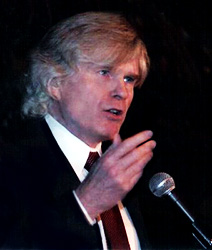 |
| Peter Brimelow: "Dividend-focused portfolios' outperformance" - a more permanent force? |
"Impressively, both have beaten the market over the last three years-that is, since the post-crash rebound," he writes.
Will blue chips and utilities outperform again in 2012? When markets surge, defensive stocks underperform as investors, large and small, quickly rotate into lower-yielding growth names. But an outright stock market boom, like we saw during 2009, is unlikely during 2012.
Corrections will come, but utilities will flourish with low rates. "Utility companies will continue their outperformance simply because their businesses thrive during such low interest rate and yield-hungry environments," says Conrad.
He also told me about several remarkably successful bond offerings proving the industry's ability to refinance. Edison International (EIX) priced in $250 million in bond debt at a record-low rate of 3.9% for 30 years. Southern Company (SO) also raised $250 million while paying only 4.1%.
"Today's low rates eliminate refinancing risk and boost utility company earnings," he said.
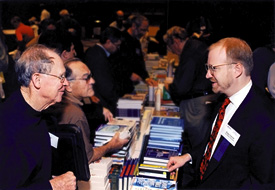 |
| Roger Conrad: No. 1 stock picker in 2011 still recommends MLPs and some utilities, despite froth. |
Conrad concedes that "it's gotten harder to choose good value picks, given the recent run-up." The Dow Jones Utility Average was up 10%, compared with a still flat S&P 500, for a one-year period through late January.
"Many of our favorite stocks are now overvalued," he adds. Those closest to his buy limits were AT&T (T-although Conrad wouldn't pay more than $33); Comcast (CMCSA, limit of $25); Verizon (V, $30); and American Water Works (AWK, $30).
7. The Economy and Politics
Surprises are in store that
will propel the US and European markets upward.
Independent US voters will elect more fiscally conservative, free-market-leaning candidates in the November election. Even if this swing does not cause President Obama to lose the White House, the Republicans should end up with control of both houses of Congress.
Absent unforeseen disasters like the 2011 earthquake in Japan, investors will begin to "discount" this as an outcome favorable to tax and regulatory certainty.
Finally, because of the expiration of the Bush tax cuts and the looming automatic budget cuts mandated by last year's agreement on the debt ceiling, Congress will enact tax and spending reforms prior to the election.
NEXT: 8. Interest Rates Remain Lower, for Longer, Than Anyone Expects
|pagebreak|8. Interest Rates Remain Lower, for Longer, Than Anyone
Expects
As growth-dampening effects from the European debt crisis
and a less than "half-speed" recovery in the US linger through the year ,
inflation and interest rates will finally "trough" during 2012.
Economists from S&P predict GDP growth-which was just 1.8% in 2011-to barely nudge upward to 2% this year, rise to 2.2% in 2013, and then jump to 3.4% by 2014. It follows that they expect inflation, as measured by the "headline" Consumer Price Index (CPI), to hit a low this year of 1.5%, followed by a slow ascent: 1.8% in 2013 and only 2% in 2014.
S&P's interest-rate forecast, however, tracks the firm's economic growth rate assumptions with a low of 2.3% on the ten-year Treasury bond this year. In 2013, it rises back to the estimated average for 2011 (2.8%). Then, by 2014, yields jump to 3.6%.
9. Intermediate-Term Loan Rates Approach a Generational
Bottom
Last year, we predicted that commercial and consumer lenders'
confidence would begin to return. This happened, but-as with most of last year's
predictions-events in Japan and Europe "postponed" what could have been expected
from a normal, if prolonged, recovery cycle.
The two forces that determine bank loan rates will converge during 2012. Loan spreads- the difference between what banks pay depositors and what they charge borrowers-will continue to narrow as confidence in the stability of collateral values and borrowers' ability to service debt improves.
The timing of the precise bottom depends most upon market psychology. Spreads still have a long way to come down. As lenders become more confident and competitive, a 3% spread could shrink to 2% or even 1%.
Borrowers looking to refinance should watch for advantageous changes in lending terms. In January, the average interest rate on a 30-year home mortgage hit a generational low level-below 3.9%.
10. China and Brazil Lead BRICs
China's economy grew at
an annual rate of 8.9% in the fourth quarter of 2011.
That is still nothing less than a phenomenal growth rate for the world's second-largest economy-which will surpass the US in gross domestic product by 2019, according to Merrill Lynch. Yet China's exports have slowed down, leaving the lowest rate of economic growth in two and a half years.
China is a managed economy. Beijing is expected to cut its interest rates later this year. Loosening monetary policy will support internal spending by Chinese consumers, "but not until later in 2012," says MoneyShow.com Senior Markets Editor Jim Jubak.
In China, Jubak recommends the Chinese Internet leader, Baidu (BIDU). However, because of the lag in China, he currently prefers Brazil, where rate cuts have already begun.
Jubak's Picks generally favors faster growing but smaller-cap leaders, including banks, cosmetic companies, and utilities.
Jubak is not a fan of country index ETF investing: "You own mostly Petrobras (PBR) and Vale (VALE) by buying Brazil's index," he says. Indeed, the two companies' preferred and common stocks made up slightly more than a third of the EWZ fund, according to iShares.
NEXT: 11. Alternative Investing Becomes a Core Strategy
|pagebreak|11. Alternative Investing Becomes a Core
Strategy
Investing academics and investment bankers and brokers
still typically recommend remaining 100% invested in a blend of bonds and
stocks. But a rebellion is brewing: "Don't Lose My Money!!!" cried the January
30 cover of Barron's.
At MoneyShow, we've created a subject tab for Alternative Investing-a catch-all for investments that correlate the least to the price movements in stocks and bonds.
Often, as in the case of real-estate investments through limited partnerships, private equity, and hedge funds, alternative investments are illiquid. Some non-correlated favorites, like managed futures, do provide daily price quotes and liquidity. Some employ so-called "tactical strategies," which go 100% into cash or ten-year bonds at the first sign of a downtrend.
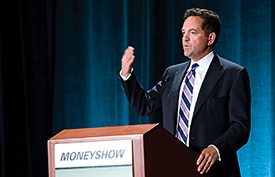 |
| Rich Karlgaard: Popularity of venture capital and angle investing is exploding. |
Another alternative investment vehicle is early-stage "angel investing" in venture funds, which "has become very popular among more sophisticated self-made entrepreneurs in semi-retirement looking to earn above market returns-the same way they made their money in the first place," Forbes publisher Rich Karlgaard told me.
MoneyShow's special commentary, "Were You Diversified or Devastated?" was well-read following the 2008 market meltdown-for good reason. This lesson is important to learn: It's not enough to spread your holdings among various markets. Now it's critical to diversify among strategies.
Only the long US bond and zero-coupon strips rose significantly in 2008 and 2011. You can reduce volatility and improve long-term total returns by owning assets and managed accounts that do not correlate to your other investments.
I have reviewed many post-bear market performance records from private equity funds, the managed commodity futures index, tactical investment managers, and the small portion of hedge funds that actually outperformed stock indexes during the "lost decade" of flat returns.
And thanks to "the invisible hand" of free-market capitalism, your cost of access to many of these alternative investments is coming down. Expenses are buckling under competitive pressure.
Don't forget that Jack Bogle's rule still applies: Intermediary expenses have the most important impact upon long-term investment returns.
How to Invest in 2012: My Conclusions
Deflation forces
will keep a lid on inflation and interest rates for all of 2012.
Copper, gold, and long-term Treasury bonds will alert you when the markets smell inflation. At that point, the Jimmy Rogers and Dennis Gartman commodity boom will shift into high gear.
And like a phoenix, real estate will surge surprisingly-as financials did in 2009.
Though this rolling transformation-a tectonic shift from deflation to steadily higher inflation in coming decades-is unsettling to equity markets, stocks will do better than they did in 2011. Greater certainty about tax and regulatory policy will bring higher stock prices by year-end.
Patient investors will finally be rewarded. You should be among them- but you will need to trade the mini bear markets along the way. Only a small portion of your portfolio should remain "buy-and-hold"
And like the generational inflation problem during the 1970s, the global debt bubble will linger for decades.
Charles Githler is Chairman and Founder of MoneyShow. He may be holding, buying, or selling investments discussed in this commentary. All the opinions expressed are his own and not necessarily those of MoneyShow.com.
































